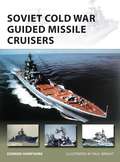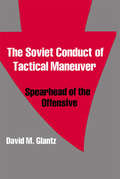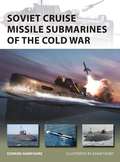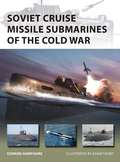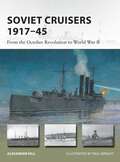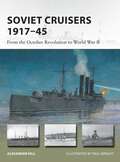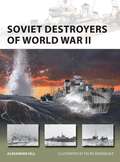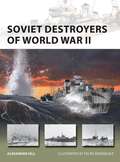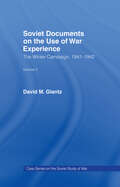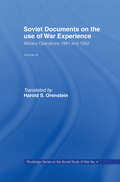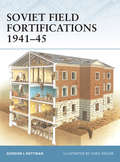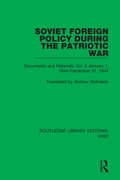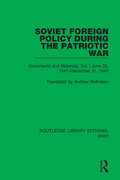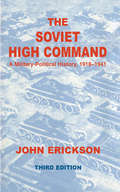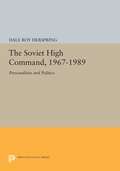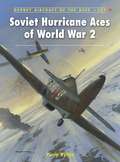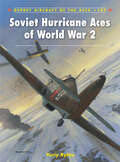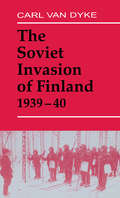- Table View
- List View
Soviet Cold War Guided Missile Cruisers (New Vanguard)
by Paul Wright Edward HampshireHeavily armed and formidable, guided missile cruisers formed the core of the Soviet Navy during the Cold War. From the last class of conventional Sverdlov-class cruisers through to increasingly complex and formidable missile cruisers, these ships ensured that NATO took the Soviet naval threat seriously. Soviet Cold War Guided Missile Cruisers covers all classes of these impressive warships, from the early Sverdlov through the Kynda, Kresta, Kara and Slava to the enormous Kirov classes. Together, these vessels marked the apogee of Soviet naval technology and capability and they remain today the largest non-aircraft carrier warships built since 1945. Containing material previously only available in Russian and fully researched from specialist defence journals, this comprehensive volume examines the design, development, and intended role of these impressive, hi-tech warships, and recounts their dramatic operational history as NATO and Soviet warships faced off against each other during the long Cold War at sea.
The Soviet Conduct of Tactical Maneuver: Spearhead of the Offensive (Soviet (Russian) Military Theory and Practice)
by David GlantzFirst Published in 1991. Routledge is an imprint of Taylor & Francis, an informa company.
The Soviet Conduct of Tactical Maneuver: Spearhead of the Offensive (Soviet (Russian) Military Theory and Practice)
by David GlantzFirst Published in 1991. Routledge is an imprint of Taylor & Francis, an informa company.
Soviet Cruise Missile Submarines of the Cold War (New Vanguard #260)
by Adam Tooby Edward HampshireThe Soviet Union's cruise missile submarines from the modified Whiskey, to the Oscar II classes were among the most formidable vessels of the Cold War. They were initially designed to carry land attack nuclear-tipped cruise missiles designed to strike targets on the eastern coast of the United States. By the late 1960s, however, submarine-launched ballistic missiles made the nuclear land-attack mission unnecessary, so existing classes were converted to the 'carrier killer' role, armed with anti-ship cruise missiles designed to destroy US super-carriers and other important naval targets. This fully illustrated study examines these powerful machines that were some of the largest and fastest submarines ever built. If war had broken out, they would have been at the forefront of the Soviet Navy's campaign to destroy NATO's sea power and cut America's sea link with Europe.
Soviet Cruise Missile Submarines of the Cold War (New Vanguard Ser. #260)
by Adam Tooby Edward HampshireThe Soviet Union's cruise missile submarines from the modified Whiskey, to the Oscar II classes were among the most formidable vessels of the Cold War. They were initially designed to carry land attack nuclear-tipped cruise missiles designed to strike targets on the eastern coast of the United States. By the late 1960s, however, submarine-launched ballistic missiles made the nuclear land-attack mission unnecessary, so existing classes were converted to the 'carrier killer' role, armed with anti-ship cruise missiles designed to destroy US super-carriers and other important naval targets. This fully illustrated study examines these powerful machines that were some of the largest and fastest submarines ever built. If war had broken out, they would have been at the forefront of the Soviet Navy's campaign to destroy NATO's sea power and cut America's sea link with Europe.
Soviet Cruisers 1917–45: From the October Revolution to World War II (New Vanguard #326)
by Dr Alexander HillA history of the Soviet Navy's cruisers, from the opening shots of the October Revolution through to the combat they saw during World War II.The Soviet Navy of World War II boasted a cruiser fleet that was among the most eclectic to see service. In this book, noted military historian and Soviet specialist Alexander Hill explains the role of cruisers in the Soviet Navy from the dramatic days of the October Revolution of 1917 through to the struggle they fought with Nazi Germany during World War II. Illustrated throughout with rare photos and original artwork, including a cutaway of Aurora, famous for its role in the Bolshevik October Revolution, and with profiles of the key classes, this book outlines the Soviets' development of a cruiser force. Having inherited a number of cruisers from the Imperial Russian Navy, the new Soviet Navy went on to complete two unfinished Tsarist light cruisers during the 1920s. In the late 1930s, the Soviets built their first large warships, the Kirov class, and in 1940 Nazi Germany sold the unfinished heavy cruiser Lützow to the USSR. The final cruiser-sized warship to see action was the former Imperial royal yacht Shtandart, renamed Marti and armed as a minelayer, which was used in the defence of Leningrad. Researched in the main from Russian-language sources, this study explores the cruiser fleet that saw considerable action in World War II, particularly in support of the Red Army.
Soviet Cruisers 1917–45: From the October Revolution to World War II (New Vanguard #326)
by Dr Alexander HillA history of the Soviet Navy's cruisers, from the opening shots of the October Revolution through to the combat they saw during World War II.The Soviet Navy of World War II boasted a cruiser fleet that was among the most eclectic to see service. In this book, noted military historian and Soviet specialist Alexander Hill explains the role of cruisers in the Soviet Navy from the dramatic days of the October Revolution of 1917 through to the struggle they fought with Nazi Germany during World War II. Illustrated throughout with rare photos and original artwork, including a cutaway of Aurora, famous for its role in the Bolshevik October Revolution, and with profiles of the key classes, this book outlines the Soviets' development of a cruiser force. Having inherited a number of cruisers from the Imperial Russian Navy, the new Soviet Navy went on to complete two unfinished Tsarist light cruisers during the 1920s. In the late 1930s, the Soviets built their first large warships, the Kirov class, and in 1940 Nazi Germany sold the unfinished heavy cruiser Lützow to the USSR. The final cruiser-sized warship to see action was the former Imperial royal yacht Shtandart, renamed Marti and armed as a minelayer, which was used in the defence of Leningrad. Researched in the main from Russian-language sources, this study explores the cruiser fleet that saw considerable action in World War II, particularly in support of the Red Army.
Soviet Destroyers of World War II (New Vanguard #256)
by Alexander Hill Felipe RodríguezThe Soviet Navy that faced the German onslaught in 1941 boasted a mixture of modern warships, often built with foreign technical assistance, and antiquated warships from the Tsarist era that were modernised for the conflict.Some Soviet naval vessels saw limited involvement in the war against Finland in 1939–1940, but the main action occurred after the German invasion, when these destroyers escorted convoys, fought battles against other destroyers and the deadly threat posed by attacking aircraft, and provided fire support for Soviet troops. From the Gnevny class of the pre-war period to the specialist destroyer leaders of the Leningrad class and the unique Tashkent, Soviet Destroyers of World War II is a detailed guide to the often forgotten destroyers of the Soviet Navy .
Soviet Destroyers of World War II (New Vanguard #256)
by Alexander Hill Felipe RodríguezThe Soviet Navy that faced the German onslaught in 1941 boasted a mixture of modern warships, often built with foreign technical assistance, and antiquated warships from the Tsarist era that were modernised for the conflict.Some Soviet naval vessels saw limited involvement in the war against Finland in 1939–1940, but the main action occurred after the German invasion, when these destroyers escorted convoys, fought battles against other destroyers and the deadly threat posed by attacking aircraft, and provided fire support for Soviet troops. From the Gnevny class of the pre-war period to the specialist destroyer leaders of the Leningrad class and the unique Tashkent, Soviet Destroyers of World War II is a detailed guide to the often forgotten destroyers of the Soviet Navy .
Soviet Documents on the Use of War Experience: Volume Two: The Winter Campaign, 1941-1942 (Soviet (Russian) Study of War)
by David M. GlantzThe Soviet Study of War" series examines the lessons Soviet military theorists and commanders learned from the study of their own military experience. These are translations of Soviet documents.
Soviet Documents on the Use of War Experience: Volume Three: Military Operations 1941 and 1942 (Soviet (Russian) Study of War)
by Harold S. OrensteinThe Soviet Study of War" series examines the lessons Soviet military theorists and commanders learned from the study of their own military experience. These are translations of Soviet documents.
Soviet Documents on the Use of War Experience: Volume Two: The Winter Campaign, 1941-1942 (Soviet (Russian) Study of War)
by Harold S. OrensteinThe Soviet Study of War" series examines the lessons Soviet military theorists and commanders learned from the study of their own military experience. These are translations of Soviet documents.
Soviet Documents on the Use of War Experience: Volume Three: Military Operations 1941 and 1942 (Soviet (Russian) Study of War)
by Harold S. Orenstein David M. GlantzThe Soviet Study of War" series examines the lessons Soviet military theorists and commanders learned from the study of their own military experience. These are translations of Soviet documents.
Soviet Field Fortifications 1941–45 (Fortress)
by Gordon L. Rottman Chris TaylorFrom June 1941, the Soviets were forced to undertake large-scale defensive operations in the face of the overwhelming German blitzkrieg assault, operations which ran counter to their preference for highly mobile, offensive warfare. Lessons were quickly learned across a wide variety of terrain and climates, including the open steppes, dense forests, wooded swamps, cities, and in snow and ice, where the availability of construction materials differed greatly. The first to cover this topic in the English language and containing detailed information about the trenches, bunkers, observation posts and weapon positions, this book examines field fortifications built from local materials by infantrymen, as well as their use of mines, field camouflage techniques, and construction tools. It provides a first fascinating insight into Russian defensive attempts against the overwhelming might of the German Army.
Soviet Field Fortifications 1941–45 (Fortress #62)
by Gordon L. Rottman Chris TaylorFrom June 1941, the Soviets were forced to undertake large-scale defensive operations in the face of the overwhelming German blitzkrieg assault, operations which ran counter to their preference for highly mobile, offensive warfare. Lessons were quickly learned across a wide variety of terrain and climates, including the open steppes, dense forests, wooded swamps, cities, and in snow and ice, where the availability of construction materials differed greatly. The first to cover this topic in the English language and containing detailed information about the trenches, bunkers, observation posts and weapon positions, this book examines field fortifications built from local materials by infantrymen, as well as their use of mines, field camouflage techniques, and construction tools. It provides a first fascinating insight into Russian defensive attempts against the overwhelming might of the German Army.
Soviet Foreign Policy During the Patriotic War: Documents and Materials. Vol. II January 1, 1944–December 31, 1944 (Routledge Library Editions: WW2 #31)
by Andrew RothsteinThis book, first published in 1946, collects documents illustrating the foreign policy of the Soviet Union during the Second World War. They show how the fighting alliance of the USSR, Britain and the USA came into being and grew stronger, how relations were restored with other anti-Nazi countries, and how diplomatic relations were extended between the USSR and hitherto un-connected countries. The collection of three parts of translated documents: statements and speeches made by Stalin; documents, treaties, agreements; appendices including press statements and telegrams.
Soviet Foreign Policy During the Patriotic War: Documents and Materials. Vol. I June 22, 1941–December 31, 1943 (Routledge Library Editions: WW2 #30)
by Andrew RothsteinThis book, first published in 1946, collects documents illustrating the foreign policy of the Soviet Union during the Second World War. They show how the fighting alliance of the USSR, Britain and the USA came into being and grew stronger, how relations were restored with other anti-Nazi countries, and how diplomatic relations were extended between the USSR and hitherto un-connected countries. The collection of three parts of translated documents: statements and speeches made by Stalin; documents, treaties, agreements; appendices including press statements and telegrams.
Soviet Foreign Policy During the Patriotic War: Documents and Materials. Vol. I June 22, 1941–December 31, 1943 (Routledge Library Editions: WW2 #30)
by Andrew RothsteinThis book, first published in 1946, collects documents illustrating the foreign policy of the Soviet Union during the Second World War. They show how the fighting alliance of the USSR, Britain and the USA came into being and grew stronger, how relations were restored with other anti-Nazi countries, and how diplomatic relations were extended between the USSR and hitherto un-connected countries. The collection of three parts of translated documents: statements and speeches made by Stalin; documents, treaties, agreements; appendices including press statements and telegrams.
Soviet Foreign Policy During the Patriotic War: Documents and Materials. Vol. II January 1, 1944–December 31, 1944 (Routledge Library Editions: WW2 #31)
by Andrew RothsteinThis book, first published in 1946, collects documents illustrating the foreign policy of the Soviet Union during the Second World War. They show how the fighting alliance of the USSR, Britain and the USA came into being and grew stronger, how relations were restored with other anti-Nazi countries, and how diplomatic relations were extended between the USSR and hitherto un-connected countries. The collection of three parts of translated documents: statements and speeches made by Stalin; documents, treaties, agreements; appendices including press statements and telegrams.
The Soviet High Command: A Military Political History, 1918-1941
by John EricksonAn objective and documentary history of the earliest origins and formative years of the Workers-Peasants Red Army from the Civil War to the initial disasters of the war with Germany, the Great Patriotic War, culminating in the "battle for Moscow" in November-December 1941.
The Soviet High Command: A Military Political History, 1918-1941
by John EricksonAn objective and documentary history of the earliest origins and formative years of the Workers-Peasants Red Army from the Civil War to the initial disasters of the war with Germany, the Great Patriotic War, culminating in the "battle for Moscow" in November-December 1941.
The Soviet High Command, 1967-1989: Personalities and Politics
by Dale Roy HerspringThe recent transformations in the USSR are nowhere more evident than in the Soviet military. Top-level military officers have been relieved of their positions, Gorbachev has warned of lean times for the military, the symbolic role of the armed forces has been downgraded, and the concept of "military sufficiency" points to major modifications in Soviet force structure. Contrary to some who see Gorbachev as a Sir Galahad out to slay the evil military high command, Dale Herspring concludes that the relationship between the highest Soviet political and military leaders is at the moment more symbiotic than conflictual. In this first in-depth study of the evolution of civil-military relations in the Soviet Union from 1967 to the present, he shows how the views of senior military officers have varied over time: currently, even if the members of the high command do not like all Gorbachev's changes, they understand the need for them and are prepared to live with them. As Herspring looks at the personalities and politics of eight top military figures, he reveals that the most important of them, Ogarkov, was the first senior Soviet military officer to understand the value of working with the political leadership. Ogarkov believed that the arms control and dtente processes, if carefully managed, could enhance the national security of the USSR. In Gorbachev, the Soviet military has found the type of individual that Ogarkov was seeking.Originally published in 1990.The Princeton Legacy Library uses the latest print-on-demand technology to again make available previously out-of-print books from the distinguished backlist of Princeton University Press. These editions preserve the original texts of these important books while presenting them in durable paperback and hardcover editions. The goal of the Princeton Legacy Library is to vastly increase access to the rich scholarly heritage found in the thousands of books published by Princeton University Press since its founding in 1905.
Soviet Hurricane Aces of World War 2 (Aircraft of the Aces #107)
by Aleksander Rusinov Yuriy RybinFollowing the destruction wrought on the Red Army Air Forces during the first days of Operation Barbarossa in June 1941, the Soviet Union found itself desperately short of fighter aircraft. Premier Josef Stalin duly appealed directly to Prime Minister Winston Churchill for replacement aircraft, and in late 1941 the British delivered the first of 3360 Hurricanes that would be supplied to the Soviet Union under the Lend-Lease agreement. Specifically requested by the USSR, the Hurricanes were quickly thrown into action in early 1942 – the Soviet Air Forces' most difficult year in their opposition to the Luftwaffe. Virtually all the Hurricanes were issued to Soviet fighter regiments in the northern sector of the front, where pilots were initially trained to fly the aircraft by RAF personnel that had accompanied the early Hawker fighters to the USSR. The Hurricane proved to be an easy aircraft to master, even for the poorly trained young Soviet pilots, allowing the Red Army to form a large number of new fighter regiments quickly in the polar area. In spite of a relatively poor top speed, and only a modest rate-of-climb, the Hurricane was the mount of at least 17 Soviet aces.
Soviet Hurricane Aces of World War 2 (Aircraft of the Aces #107)
by Yuriy RybinFollowing the destruction wrought on the Red Army Air Forces during the first days of Operation Barbarossa in June 1941, the Soviet Union found itself desperately short of fighter aircraft. Premier Josef Stalin duly appealed directly to Prime Minister Winston Churchill for replacement aircraft, and in late 1941 the British delivered the first of 3360 Hurricanes that would be supplied to the Soviet Union under the Lend-Lease agreement. Specifically requested by the USSR, the Hurricanes were quickly thrown into action in early 1942 – the Soviet Air Forces' most difficult year in their opposition to the Luftwaffe. Virtually all the Hurricanes were issued to Soviet fighter regiments in the northern sector of the front, where pilots were initially trained to fly the aircraft by RAF personnel that had accompanied the early Hawker fighters to the USSR. The Hurricane proved to be an easy aircraft to master, even for the poorly trained young Soviet pilots, allowing the Red Army to form a large number of new fighter regiments quickly in the polar area. In spite of a relatively poor top speed, and only a modest rate-of-climb, the Hurricane was the mount of at least 17 Soviet aces.
The Soviet Invasion of Finland, 1939-40 (Soviet (Russian) Military Experience #No. 3)
by Carl Van DykeWestern accounts of the Soviet-Finnish war have been reliant on Western sources. Using Russian archival and previously classified secondary sources to document the experience of the Red Army in conflict with Finland, Carl Van Dyke offers a reassessment of the conflict.
